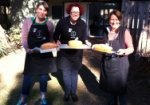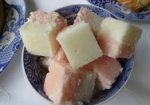Adapting recipes for modern tastes is a challenge: we have expectations of what a dish should taste like, what it goes with, how and even when it should be eaten, which are generally culturally learned. There are recipes that are achievable but may not be deemed acceptable on all tables these days – jelly is a good example. It was once revered on the finest society tables but you’d rarely find jelly served anywhere but at children’s party or possibly at yum cha.
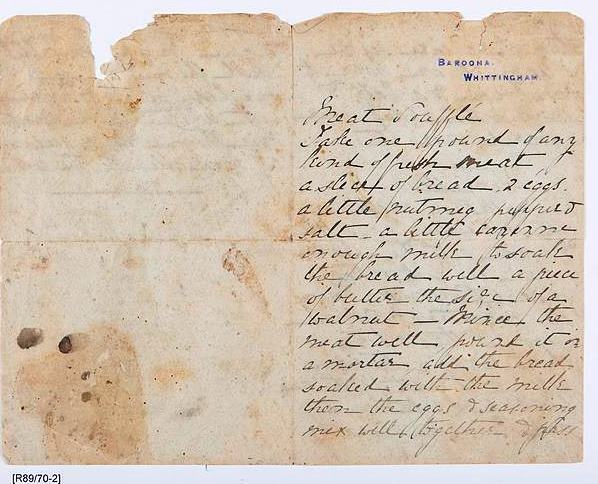
Meat souffle recipe. Rouse Hill House and Farm collection R89/70-1 Photo © Sydney Living Museums
Manuscript recipes from the Rouse Hill House and Farm collection for ‘meat soufflé’ and ‘quenelles’ are another example of a once admired dish that might not quite ‘cut the mustard’ on modern tables.
Meat Souffle
Take one pound of any kind of fresh meat, a slice of bread, 2 eggs, a little nutmeg, pepper & salt, a little cayenne enough milk to soak the bread with a piece of butter the size of a walnut – Mince the meat well pound it in a mortar, and the bread soaked with the milk & then the eggs & seasoning mix well together & pass // through a wire sieve. Steam for an hour to an hour & a half & serve with white sauce poured over it.
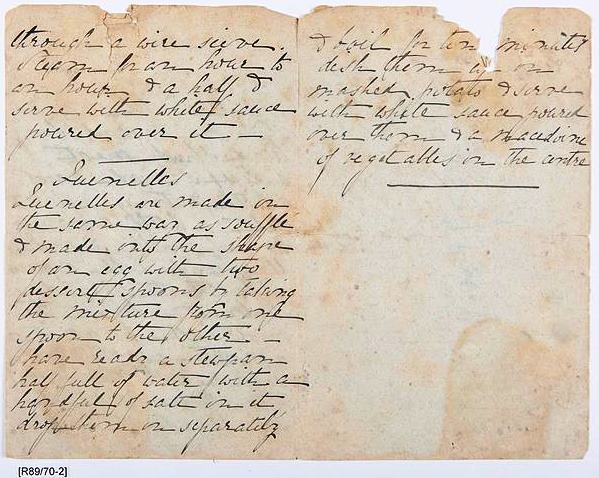
Meat souffle (continued) and Quenelles recipe. Rouse Hill House and Farm collection R89/70-2 Photo © Sydney Living Museums
Quenelles
Quenelles are made in the same way as soufflé & made into the shape of an egg with two dessert spoons by taking the mixture from one spoon to the other – have ready a stewpan half full of water with a handful of salt in it drop them in separately & boil for ten minutes dish them up on mashed potato & serve with white sauce poured over them & a macedoine of vegetables in the centre
Family connections
The recipes are written on personalised writing paper marked ‘Baroona Whittingham’. Baroona, near Singleton, was the family home of Phoebe Dangar, nee Rouse. Designed by colonial architect, Horbury Hunt who also designed the stables at Rouse Hill House, the homestead still stands today. Families were surprisingly mobile throughout the C19th and the various members of the Rouse family would frequent each others homes, often staying for weeks at a time. A recipe can be a souvenir or touchstone, providing a way of ‘revisiting’ a place, a family member or a memory at a later time.
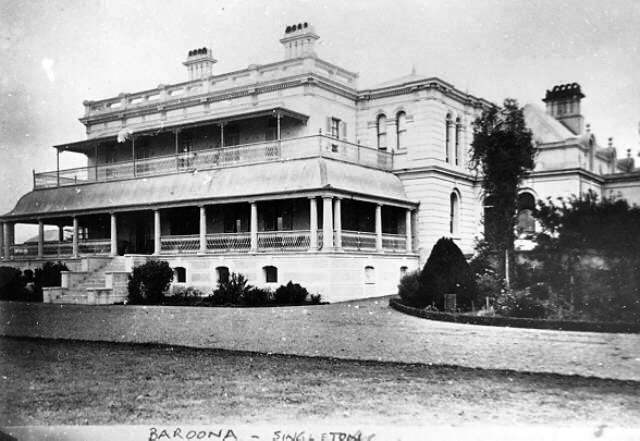
‘Baroona – Singleton’ Whittingham- Historic Houses. Image reproduced courtesy Newcastle Region Library
Lamb in sheep’s clothing?
Essentially these are a very fine-textured meatloaf and meatballs, respectively, served with a white sauce. Rather than baking the meatloaf or pan frying the meatballs as we might today, the meat souffle is steamed and the quenelles boiled in water. With no added flavours specified on the recipe – herbs? salt and pepper? – when recipe tested they were something of a let-down. But someone taking the time to write out the recipes indicates that they were worthy of recording. Perhaps they were served to a guest who was so impressed they wanted to be able to make it themselves at home, or dishes that one of the family or a friend recommended because they liked them.
Many of us would think these minced-based dishes relatively ordinary, perhaps even humble, however the names themselves elevate them above the every-day. Indeed they may have seemed quite refined, as without the benefit of modern mincing equipment they involved quite a bit of work and considerable mess, having to push the meat through a sieve to achieve the fine texture – a job that can be done in mere minutes in a food processor.
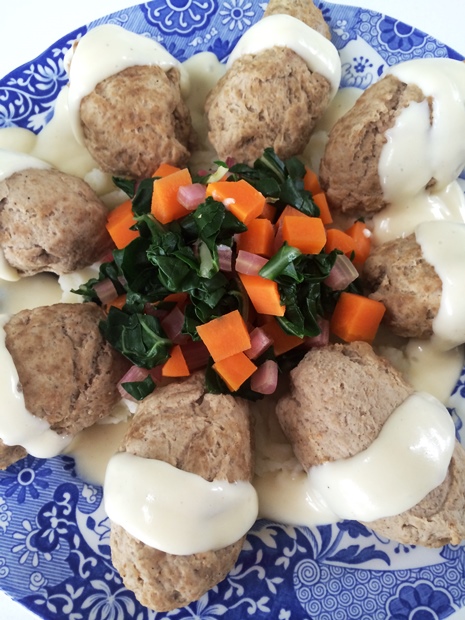
Quennelles made to an heirloom recipe in the Rouse family collection, Rouse Hill House and Farm. Photo © Jacqui Newling for Sydney Living Museums
‘Dead meat in shampoo’
I was interested to find on a very slick food blog from Denmark, Aorta Food, that poached meatballs served in a velouté-style white sauces are something of a cultural classic in Scandinavia and among their favourite comfort foods. The author of the article, chef at Draggsholm Castle, Claus Henriksen, notes that ‘Granted: Often it looks like dead meat in shampoo’ and proffers a more sophisticated recipe using fermented asparagus instead of the more traditional celery in the sauce.
It seems that quenelles (boiled meatballs) are not lost to history but a celebrated tradition that has been maintained in other parts of the world. As for its larger variation, the meat souffle (steamed meatloaf), I’m yet to find evidence of it surviving elsewhere.
Meat souffle and Quenelles
Ingredients
- 450g minced beef, or blended pork and veal
- 1 medium slice day-old or stale bread
- 3 tablespoons milk
- 1 heaped teaspoon butter, melted
- 2 eggs, beaten
- 1/4 teaspoon ground nutmeg
- cayenne pepper or chilli powder, to taste
- salt and pepper, to taste
- 1 cup white, or bechamel sauce, to serve
Note
This ‘souffle’ is more like a finely textured meatloaf. ‘Quenelles’ were made in the same way, but formed into small football shapes and poached or steamed. You may prefer to pan fry the meat once formed into shape, and finish off in the oven for more colour; similarly you can flavour the white sauce if you wish, or substitute with gravy. These changes would spoil the authenticity of the dishes, however.
They were served with mashed potato and ‘macedoine’ or a mix of diced vegetables.
Directions
| Pound the meat in a mortar and pestle until smooth, or process in a food processor for a few minutes. | |
| Place the bread in a shallow dish, pour the milk and butter over and allow it to absorb, adding a little extra milk if necessary. Transfer the meat to a bowl, add the bread, eggs and seasonings and combine well, using your hands or a fork to blend through. Return the mixture to the mortar and pestle or food processor, and pound or process until the bread is fully incorporated. (The original recipe instructs to then push the meat through a wire sieve, but if using a food processor this should not be necessary.) | |
| For the ‘souffle’, form the meat into a log or round loaf shape. Place the meat onto a steaming rack over a few centimetres of boiling water in a deep saucepan (or stand a plate upon a coffee mug to keep it above water level). Steam, lid on, for 1 to 1½ hours, topping up the water as necessary. | |
| For quenelles, form the meat into small oval or egg shapes and cook a few at a time in a pot of boiling salted water, for ten minutes or until cooked through. To serve, arrange the quenelles on a serving plate and pour white sauce over them. | |
| To serve, slice the ‘souffle’, arrange on a plate and pour white sauce over. | |
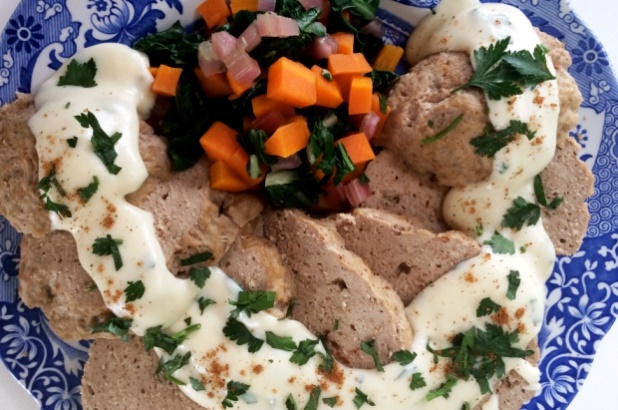
 Print recipe
Print recipe
